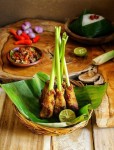BALI, DEPOSTBALI
This one food must be familiar to all of us. Sate lilit is a mainstay dish that is often hunted by tourists when visiting the Island of the Gods. The term 'lilit' in Balinese and Indonesian means 'to wrap' like a satay wrapper which is wrapped around a thick and wide skewer.
Sate lilit originally came from Klungkung. However, now this food is easily available in other areas of Bali such as Badung, Gianyar, and Denpasar.
Baca juga: Inilah Fakta Unik Tentang Bali yang Belum Kamu Tahu
Baca juga: Ramalan Zodiak Besok 18 Juli 2021, Pisces dan Libra Kelelahan
In the past, sate lilit was only made from pork and fish. This is because the majority of the population of Bali is Hindu. However, now sate lilit can be made from minced beef, chicken, or even turtle. This happens to meet the demand of tourists who can not eat pork.
sate lilit is a food that is in the offerings of Balinese Hindus at traditional ceremonies. One of them is the traditional Caru ceremony. This traditional ceremony aims to maintain the balance of the universe. In addition, Caru is also held as a form of respect and appreciation to the gods of Hindus in Bali.
Baca juga: Resep Makanan Enak, Cara Membuata Ayam Bumbu Bali yang Bikin Nagih
Baca juga: The Meaning of Black and White Plaid Fabric in Bali
In the offerings, an odd number of satay wraps is served. Generally, satay wrap is served as much as 3 or 5 sticks. This satay wrap is then tied together and placed between the lawar which is a symbol of the wind's eye. Each cardinal direction is guarded by the gods. There are 4 types of lawar, namely black, white, red, and green lawar.
In big ceremonies, satellites are made at the village hall and carried out by 50-100 men. All work, from slaughtering animals, mixing dough, wrapping meat, to cooking is done by men. This satay is a symbol of male virility. In the past, people would question a man's virility if he couldn't make satay wraps.
Baca juga: Jatiluwih Village Tabanan Bali, Village With Enchanting Rice Field View




